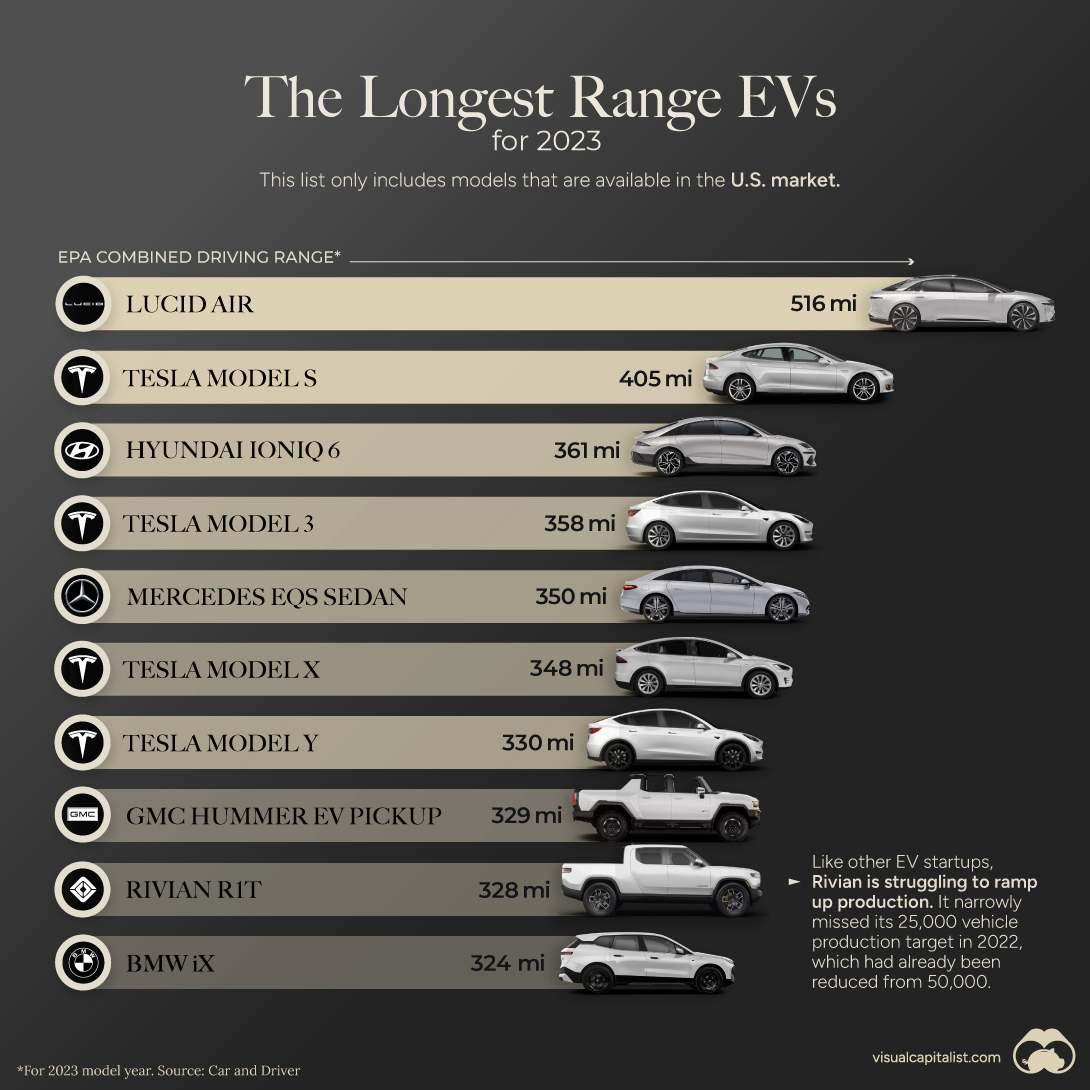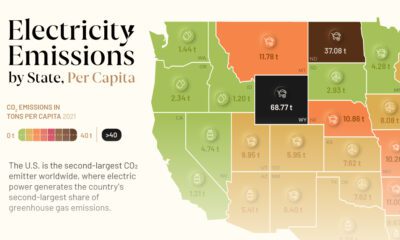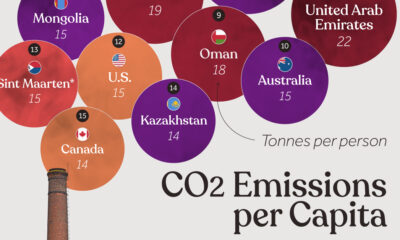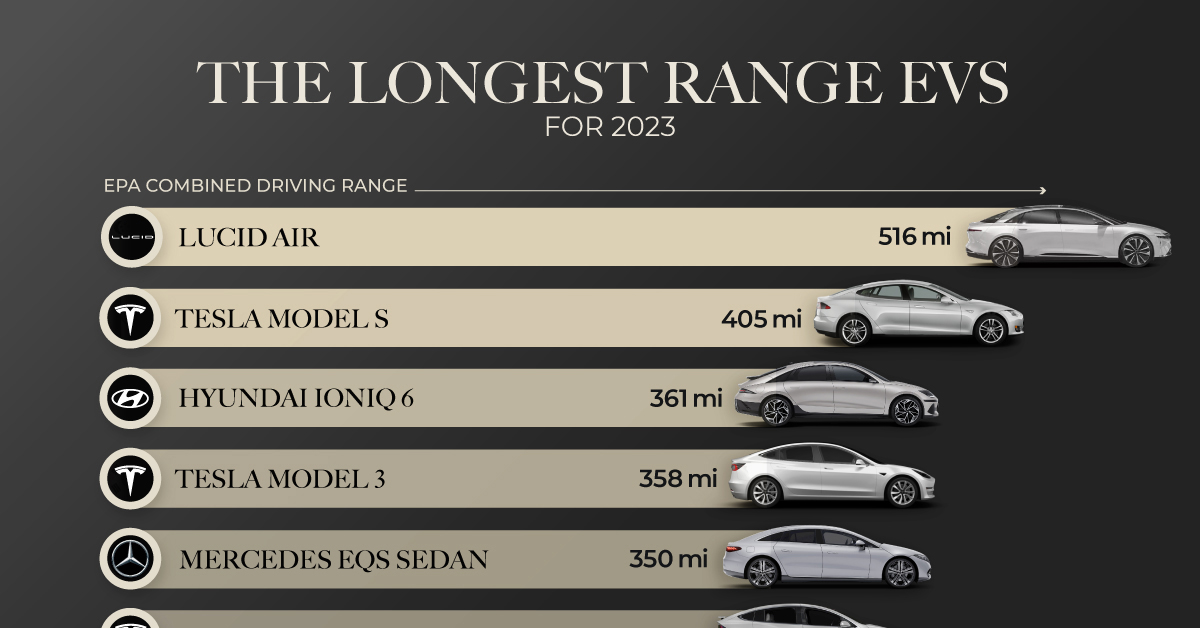Datastream
Can You Calculate Your Daily Carbon Footprint?
The following content is sponsored by Carbon Streaming Corporation

The Briefing
- A person’s carbon footprint is substantial, with activities such as food consumption creating as much as 4,500 g of CO₂ emissions daily.
- By purchasing carbon credits from Carbon Streaming Corporation, you can offset your own emissions and fund positive climate action.
Your Everyday Carbon Footprint
While many large businesses and countries have committed to net-zero goals, it is essential to acknowledge that your everyday activities also contribute to global emissions.
In this graphic, sponsored by Carbon Streaming Corporation, we will explore how the choices we make and the products we use have a profound impact on our carbon footprint.
Carbon Emissions by Activity
Here are some of the daily activities and products of the average person and their carbon footprint, according to Clever Carbon.
| Household Activities & Products | CO2 Emissions (g) |
|---|---|
| 💡 Standard Light Bulb (100 watts, four hours) | 172 g |
| 📱 Mobile Phone Use (195 minutes per day)* | 189 g |
| 👕 Washing Machine (0.63 kWh) | 275 g |
| 🔥 Electric Oven (1.56 kWh) | 675 g |
| ♨️ Tumble Dryer (2.5 kWh) | 1,000 g |
| 🧻 Toilet Roll (2 ply) | 1,300 g |
| 🚿 Hot Shower (10 mins) | 2,000 g |
| 🚙 Daily Commute (one hour, by car) | 3,360 g |
| 🍽️ Average Daily Food Consumption (three meals of 600 calories) | 4,500 g |
| *Phone use based on yearly use of 69kg per the source, Reboxed | |
Your choice of transportation plays a crucial role in determining your carbon footprint. For instance, a 15 km daily commute to work on public transport generates an average of 1,464 g of CO₂ emissions. Compared to 3,360 g—twice the volume for a journey the same length by car.
By opting for more sustainable modes of transport, such as cycling, walking, or public transportation, you can significantly reduce your carbon footprint.
Addressing Your Carbon Footprint
One way to compensate for your emissions is by purchasing high-quality carbon credits.
Carbon credits are used to help fund projects that avoid, reduce or remove CO₂ emissions. This includes nature-based solutions such as reforestation and improved forest management, or technology-based solutions such as the production of biochar and carbon capture and storage (CCS).
While carbon credits offer a potential solution for individuals to help reduce global emissions, public awareness remains a significant challenge. A BCG-Patch survey revealed that only 34% of U.S. consumers are familiar with carbon credits, and only 3% have purchased them in the past.
About Carbon Streaming
By financing the creation or expansion of carbon projects, Carbon Streaming Corporation secures the rights to future carbon credits generated by these sustainable projects. You can then purchase these carbon credits to help fund climate solutions around the world and compensate for your own emissions.
Ready to get involved?
>> Learn more about purchasing carbon credits at Carbon Streaming
Datastream
The 10 Longest Range EVs for 2023
This infographic lists 10 of the longest range EVs currently for sale in the U.S. in 2023. The Lucid Air takes first place at 516 miles.

The Briefing
- EV models with over 300 miles (480 km) of range are becoming more common in the United States
- The Lucid Air (Grand Touring trim) has the highest EPA range at 516 miles (830 km)
The 10 Longest Range EVs for 2023
Range anxiety is frequently cited as one of the biggest turnoffs of electric vehicles (EVs).
Even as recent as 2021, the average range of an EV was just 217 miles (349 km), falling significantly short from the average gas car’s range of 413 miles (665 km). Thankfully, as this infographic shows, EVs with over 300 miles of range are becoming more common.
Below are the top 10 EVs for 2023, ranked by their EPA combined driving range. For further context, we’ve also included price. These values are for the specific trim that achieves the stated range. In some cases, more expensive trims are available but have a lower range (e.g. Tesla Plaid).
| Model | EPA Combined Driving Range | Price* |
|---|---|---|
| Lucid Air | 516 mi (830 km) | $138,000 |
| Tesla Model S | 405 mi (652 km) | $84,990 |
| Hyundai Ioniq 6 | 361 mi (581 km) | $45,500 |
| Tesla Model 3 | 358 mi (576 km) | $55,990 |
| Mercedes-Benz EQS | 350 mi (563 km) | $104,400 |
| Tesla Model X | 348 mi (560 km) | $94,990 |
| Tesla Model Y | 330 mi (531 km) | $52,990 |
| GMC Hummer EV Pickup | 329 mi (529 km) | $110,295 |
| Rivian R1T | 328 mi (528 km) | $74,800 |
| BMW iX | 324 mi (521 km) | $87,100 |
*Most recent prices available as of April 2023
Note that the EV market is rapidly evolving, and the data in this table has a limited shelf life. For example, Rivian is releasing a battery option dubbed the “Max pack” which promises up to 400 miles, but is not yet EPA rated.
Where Does This Data Come From?
Source: Car and Driver (range), manufacturer websites (price)
-

 Debt1 week ago
Debt1 week agoHow Debt-to-GDP Ratios Have Changed Since 2000
-

 Markets2 weeks ago
Markets2 weeks agoRanked: The World’s Top Flight Routes, by Revenue
-

 Countries2 weeks ago
Countries2 weeks agoPopulation Projections: The World’s 6 Largest Countries in 2075
-

 Markets2 weeks ago
Markets2 weeks agoThe Top 10 States by Real GDP Growth in 2023
-

 Demographics2 weeks ago
Demographics2 weeks agoThe Smallest Gender Wage Gaps in OECD Countries
-

 United States2 weeks ago
United States2 weeks agoWhere U.S. Inflation Hit the Hardest in March 2024
-

 Green2 weeks ago
Green2 weeks agoTop Countries By Forest Growth Since 2001
-

 United States2 weeks ago
United States2 weeks agoRanked: The Largest U.S. Corporations by Number of Employees














